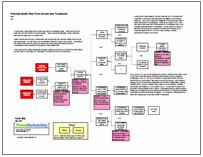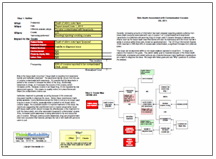Electronic fetal heart rate monitoring (EFM) is used to determine fetal distress. When fetal distress is indicated, intervention and/or early delivery are generally performed. Because of this, EFM is performed frequently, even in low risk births. However, EFM has a high rate of false positives, resulting in unnecessary surgical intervention, which can impact both patient safety and an organization’s goals, especially as the rate of cesarean sections continue to increase. One of the causes for these high rates of false positives is the variable and inconsistent interpretation of EFM data. This is in itself an impact to the patient services goal.
This produces a highly simplified version of the Cause Map, but leads to a cause that has significant opportunity to provide improved results. Specifically, the cause of “variable and inconsistent interpretation” suggests that guidance for more consistent interpretation may aid in reducing unnecessary surgical intervention due to false positives from EFM.
With guidance provided from the American Family Physician, we can create a process map to aid in the use of EFM. A process map shows the steps and decision trees involved in a process, attempting to guide practitioners towards accepted best practices.
 EFM is used continuously for high risk patients and intermittently for low risk patients unless abnormalities occur. There are three types of patterns produced by EFM: reassuring, non-reassuring, and ominous. (Definitions for these patterns, as well as high risk patients are also from the American Family Physician). Reassuring patterns generally are found to correlate with fetal health, and indicate that the delivery can continue. Ominous patterns should lead to evaluation for immediate delivery. Non-reassuring patterns are found between the two – and so lead to the most difficulty in interpretation. Specific steps are outlined to be taken in the case of non-reassuring patterns which attempt to normalize the pattern. Additionally, specific tests are recommended to attempt to determine the cause. If the cause can be determined and corrected, continuous monitoring should accompany an attempt to continue the delivery.
EFM is used continuously for high risk patients and intermittently for low risk patients unless abnormalities occur. There are three types of patterns produced by EFM: reassuring, non-reassuring, and ominous. (Definitions for these patterns, as well as high risk patients are also from the American Family Physician). Reassuring patterns generally are found to correlate with fetal health, and indicate that the delivery can continue. Ominous patterns should lead to evaluation for immediate delivery. Non-reassuring patterns are found between the two – and so lead to the most difficulty in interpretation. Specific steps are outlined to be taken in the case of non-reassuring patterns which attempt to normalize the pattern. Additionally, specific tests are recommended to attempt to determine the cause. If the cause can be determined and corrected, continuous monitoring should accompany an attempt to continue the delivery.
If the pattern is not normalized, evaluation for immediate delivery should occur. There is no decision tree at this stage because the decision on whether (and how quickly) to perform delivery must be determined based on the patient’s specific state, based on the knowledge of the practitioner. Although some steps remain subjective, attempting to fit those that are not into a process map can improve the odds for everyone.









